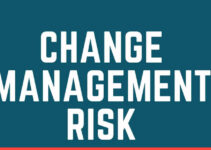Change management risk consists of compromised quality standards, high cost, and delayed implementation impacting the end results of the company. Various factors could negatively impact the company from achieving desired changes because of limited planning and support from the team members and stakeholders. Today, we’ll discuss the change management risk examples; various types of risks; steps involved in risk comprehension; and top examples.
Types of Change Management Risks
- Disbelief and uncertainty about the change project
- Confusion about the company’s need for change
- Improper change management framework
- Limited governance
- Limited team members to perform the tasks
- Funds and budget limitation
- No guide and direction from the company’s senior management and leadership
- Limited support from partners and stakeholders
Steps involved in comprehending change management risks
- Clearly defining the desired outcomes
- Determining the necessary changes to make sure a successful change project achieves the desired results
- Recognizing the resistance and barriers that stop the company from the change project
- Creating a failure-resistant change management plan and strategic approach
Decreasing the Change Management Risk Factors
- Discussing the significance of risk associated with all the partners and stakeholders
- Envisioning the future state after implementing the desired changes
- Establishing a supportive team and infrastructure for the change project
- Developing a milestone and roadmap for the company to achieve changes
- Improvement efforts and steps to deal with risk factors in the business process
Top Change Management Risk Examples
Let’s discuss the top change management risk examples; they’re as follows;
Limited Support from Stakeholders & Team Members
Limited support from employees, team members, and stakeholders is one of the top change management risk factors. When team members and stakeholders don’t fully comprehend the change project, they won’t agree with the change plan. As a result, employees would resist the change initiative and take steps to jeopardize the success rate of the change project.
Microsoft – Integrating Automation System & Faced Employees’ Resistance
Microsoft was dealing with the problem of managing worldwide operations and tracking sales in 2020. The tech company’s old system didn’t have the latest automation features, and it resulted in the form of duplication and misalignment of data. However, when the tech giant company introduced the new system relevant to the prevailing needs and requirements; the company faced a lot of resistance from its employees because they were reluctant to follow the new process.
Improper Change Strategic Approach
Improper and inadequate change strategic approach is a leading risk factor for the change project. Companies should make sure that they are implementing the right change strategy that would increase the success rate of the change initiative. It is highly difficult for the company to achieve success without effective implementation of the change strategy or change processes.
Kodak – Failed to Implement Digitalization Strategy
Kodak used to be the top film and camera manufacturing company for decades. Some employees floated the idea of digital cameras to the company’s management, and they rejected it because it was contrary to the company’s sale of films and cameras.
However, other competitive companies pushed digital cameras into the market in the 1990s and digital media platforms further amplified the growth of digital photos. By the time Kodak implemented the change and launched a digital camera; it was very late. Kodak filed for bankruptcy in 2012.
Ineffective Communication
Open and transparent communication with team members and stakeholders plays a key role in achieving the desired changes. Ineffective communication is one of the leading risk factors in the change project. In fact, a change project won’t be successful if the top management isn’t listening to the feedback of employees and not clearly communicating the changes. It is nearly impossible to launch transformational changes in a closed organizational culture.
Nokia – Rigid Organizational Culture
Nokia used to have the highest market share in mobile phones globally. The company had the top experts and professionals in its team. However, the company had a very rigid organizational structure and culture; where the management was making decisions separately without consulting it with the tech team. Nokia removed the position of CTO (chief technical officer) from its management team.
Nokia’s employees were hesitant and fearful to share their ideas with the company’s leadership. As a result, Nokia lost the global market leadership position at the hands of Samsung and Apple.
Change Execution Timeline Issues
The change project requires a specific timeline and the deadline for the change project is highly significant. It allows businesses and companies to avoid abandonment, delays, and slowdowns. However, when the change project takes a lot of time, then it becomes highly expensive for the company to achieve the desired results.
Limited Change Control Measures
When a company doesn’t review and analyze the performance of its change project on time, then it becomes highly risky. The change progress won’t achieve proper growth and progress without having proper change control measures.
Conclusion: Top Change Management Risk Examples
After an in-depth study of the top change management risk examples; we have realized that change management is a highly risky venture. If you are learning about the top 5 change management risk examples; then you should keep in mind abovementioned risk examples of Microsoft, Nokia, and Kodak.
Ahsan is an accomplished researcher and has a deep insight in worldly life affairs. He goes Live 3 days a week on various social media platforms. Other than research writing, he’s a very interesting person.


